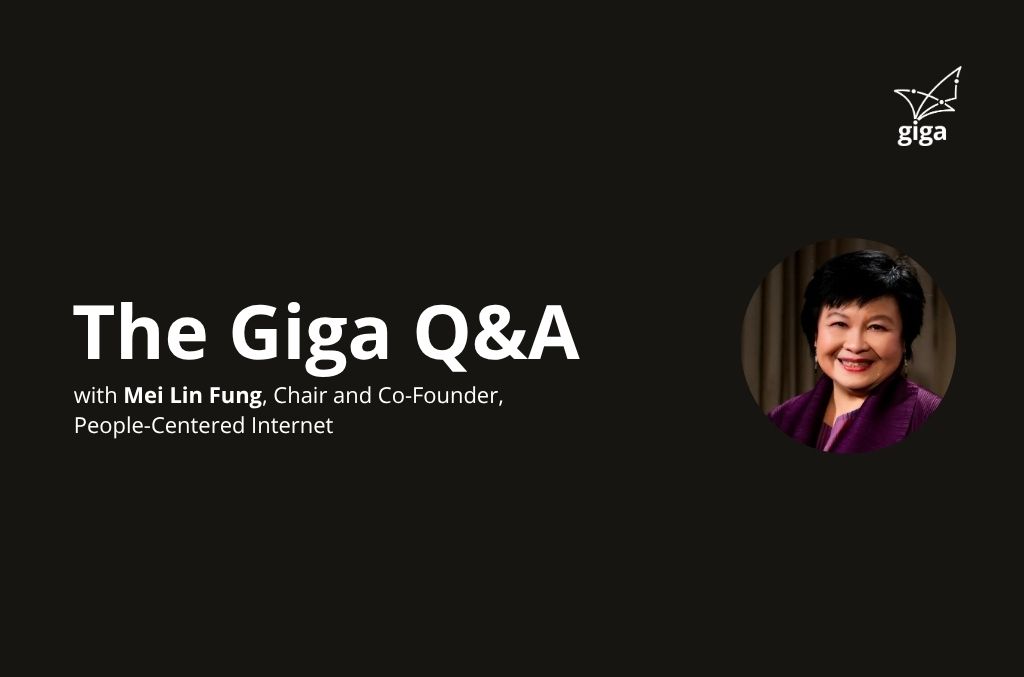Mei Lin Fung is Chair and Co-Founder of the People Centered Internet, begun in 2015 (with Vint Cerf, often called “a father of the internet”), which works to create a more equitable digital world. A tech pioneer and contributor to enterprise resource planning (ERP) software, she integrated a key analytic tool, Customer Lifetime Value, into customer relationship management (CRM) systems. Among other roles, she serves on the advisory council of Govstack, a UN initiative to develop common technology building blocks for digital government services, and is a nominated Vice Chair of the UN AI for Good Impact Initiative.
1. Globally, 2.6 billion people still lack access to the internet. What is your view on how to close this digital divide?
I approach this issue differently because I grew up in Singapore. In the 1960s, Singapore was a global South country with a GDP per capita of just $500 USD. It was poverty-stricken, and the odds seemed insurmountable. However, our leadership had a vision: we would not depend on aid but rather leverage education, trade, innovation to attract global investment to lift ourselves. Today, Singapore is one of the richest countries in the world on a per capita basis, the only country in the top five with no natural resources except for people.
But here’s the key: it must be driven locally. Charitable efforts alone create dependency, whereas investing in local capacity creates independence and sustainable growth. My Singapore experience profoundly shapes my belief that connectivity and access to global opportunities can transform any nation when obstacles are removed so that people have the opportunity to help themselves.
2. What are the challenges in promoting this vision?
The kind of national transformation Singapore achieved relied on a unique moment in time: a cohesive society, rising incomes and geopolitical advantage at the crossroads of global trade. Its government could mandate high savings rates and channel them into long-term investments. Today, the challenge is different. We’re in a fragmented, fast-moving, global investment marketplace. Public infrastructure, especially digital public infrastructure like Giga, must now compete for attention and funding on global terms. So the question becomes: How do we make digital infrastructure investable? We can take a page from the U.S. housing market. When banks wouldn’t lend to homeowners without physical collateral, Fannie Mae stepped in—standardizing loans, guaranteeing repayment and enabling securitization. This was made possible by land title registries that proved ownership and value. Today, we need a 21st-century equivalent—not for land, but for digital property. Giga can become a digital asset registry—a platform that captures the value being created in and around schools: learning outcomes, student-led innovation, community projects and small digital enterprises. Schools and communities could register the digital outputs they create as investment-ready digital property. Regional securitization utilities could pool digital assets across borders, lowering risk and giving global investors a clearer picture of opportunity. This could unlock new financing pathways for millions of students, educators and local innovators.
3. Connectivity, therefore, is not only about access, but longer-term social and economic benefits. How can we communicate these benefits more effectively?
We need to shift the conversation from “access” to “impact”—and the good news is, digital networks now give us the ability to do that in ways never before possible. The internet and mobile phones create digital footprints that allow us to track activity, progress and outcomes. When MSMEs (micro, small or medium enterprises) or schools come online, they generate data—from participation to performance to engagement with digital tools. If we can capture and structure this data, we can begin to show how connectivity leads to tangible benefits: improved learning outcomes, more resilient livelihoods stronger local economies.
These are the stories that need to be told—and the data that needs to be seen. But it’s not just about tracking individual projects. What’s truly powerful is collective visibility. When we can observe patterns across hundreds or thousands of schools or SMEs in a region, We begin to understand the pathways to success—and equally important, where and why progress stalls. We often say “you can’t manage what you don’t measure.” Giga, by connecting every school, lays the foundation for this kind of shared intelligence in digital development. That’s how we communicate the long-term benefits of the internet: by showing not just what’s being built, but what’s being made possible.
4. How do you envision the internet evolving over the next 10 to 15 years?
Over the next decade and beyond, the internet will mature into a fully-fledged layer of digital public infrastructure (DPI)—not just for communication, but for trusted transactions, inclusive innovation and equitable growth. We’re already seeing the components emerge: identity, payments and cross-border data flows. To truly deliver on its promise, DPI must be anchored in inclusion, and that begins with connectivity to schools. The movement is gaining traction in many countries, and it is critical that Giga collaborates to ensure that school connectivity and education access are fully integrated into these DPI efforts.

